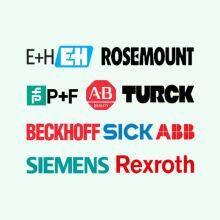Endress+Hauser Dissolved oxygen sensors
- 26 Unit / Units per Month
You May Like
Product Details
| Brand Name | Endress+Hauser | Place of Origin | Germany |
Product Description
Endress+Hauser Dissolved Oxygen Sensors Operation Manual
1. Introduction
In various industrial and environmental monitoring fields, the measurement of dissolved oxygen (DO) is crucial. It not only reflects the health status of water bodies but is also an indispensable parameter in industries such as wastewater treatment, fisheries, and beverage production. E+H dissolved oxygen sensors, with their high precision, stability, and ease of operation, have become one of the preferred instruments in these fields. This manual aims to provide users with detailed operating instructions to ensure correct and efficient use of Endress+Hauser dissolved oxygen sensors for daily testing tasks.
2. Working Principle of Endress+Hauser Dissolved Oxygen Sensors
Endress+Hauser dissolved oxygen sensors primarily adopt the electrochemical method to measure dissolved oxygen concentration. The sensor consists of an electrode body, electrolyte, and cable. The electrode body is the key component for measuring dissolved oxygen concentration and is composed of two sensors (cathode and anode) and an oxygen permeable membrane. When the cathode receives current from the working electrode, it begins to adsorb oxygen. Oxygen molecules combine with ions in water molecules to form oxygen ions, which move towards the anode and release electrons. The electrons return to the working electrode through the cable, forming a complete oxygen analysis circuit. The anode receives current through the cable signal line, producing an electrochemical reaction that reduces the concentration of reducing substances in the water and affects the concentration of oxygen ions. The electrolyte is an important component of the dissolved oxygen sensor, responsible for providing sufficient ion concentration to the electrode and neutralizing the charge generated by the reaction. E+H dissolved oxygen electrodes typically use seawater or phosphate solutions as electrolytes, and sometimes organic liquids to improve measurement accuracy.
3. Installation Guide
3.1 Site Selection
Choose a location that can reflect the representative dissolved oxygen content of the monitored water body. The location should avoid adverse factors such as direct sunlight, high temperature, and electromagnetic interference. The installation location should facilitate easy insertion of the probe into the water and avoid agitation by water flow or other factors to reduce the impact on dissolved oxygen concentration. Additionally, the installation location should be convenient for later maintenance and overhaul.
3.2 Tools and Materials Preparation
Prepare necessary tools and materials according to the installation instructions of the online dissolved oxygen monitor, such as screwdrivers, wrenches, cables, connectors, brackets, etc.
3.3 Equipment Inspection
Ensure that the online dissolved oxygen monitor and its accessories (such as sensors, cables, etc.) are intact without damage or missing parts.
3.4 Bracket Installation
Select an appropriate bracket installation method based on the site conditions to ensure that the bracket is stable and facilitates sensor sampling. The bracket should be able to bear the weight of the equipment and ensure stable installation of the online dissolved oxygen monitor.
3.5 Sensor Installation
Fix the dissolved oxygen sensor on the bracket, ensuring that the sensor probe is completely immersed in the water and the immersion depth is appropriate (it is generally recommended to install it at a position 30cm below the minimum water level and not exceeding a depth of 2 meters). The sensor should be installed vertically with the electrode facing downwards, and it should not be installed horizontally or with the electrode facing upwards. At the same time, pay attention to protecting the sensor probe to avoid mechanical damage or chemical corrosion.
3.6 Parameter Setting
Set the parameters of the online dissolved oxygen monitor according to actual needs, such as sampling frequency, alarm values, etc. Ensure that the parameter settings are correct to obtain accurate measurement results.
4. Troubleshooting
4.1 Common Fault Codes
During use, if a fault occurs, the instrument will display a corresponding fault code to help users quickly locate and solve the problem. Common fault codes include E32, E45, etc., each corresponding to a specific fault cause.
4.2 Solutions to Fault Code E32
Fault code E32 in the E+H oxygen meter usually indicates a problem with the dissolved oxygen sensor. This may be caused by sensor aging, electrode surface contamination, membrane damage, or electrolyte problems.
Check for sensor aging or damage: If the sensor has been used for a long time, aging may occur, leading to inaccurate measurement data. In this case, replace the sensor with a new one.
Clean the electrode surface: The electrode surface is easily contaminated, affecting the detection accuracy of dissolved oxygen. Regularly clean the electrode surface using a soft cloth or cotton swab dipped in an appropriate amount of cleaner to remove dirt and algae.
Check for membrane damage: If the membrane is damaged or aged, it will affect oxygen permeability and measurement accuracy. In this case, replace the membrane with a new one.
Check the electrolyte: The electrolyte is a key component of dissolved oxygen measurement. If the electrolyte has problems such as deterioration, contamination, or insufficiency, it will lead to measurement abnormalities. Replace the electrolyte regularly and ensure its quality is qualified.
Conclusion
This manual provides a comprehensive guide to the operation, installation, maintenance, troubleshooting, and safety information of Endress+Hauser dissolved oxygen sensors. By following the instructions outlined in this manual, users can ensure the accurate and reliable measurement of dissolved oxygen, effectively supporting various water quality monitoring tasks.
Contact Us

- Ningbo Yuantao Import&Export Co.,Ltd.
- Contact nameNick Xu Chat Now
- AddressYinzhou District, Ningbo, Zhejiang
New Products
-
Endress+Hauser pH transmitters
-
Endress+Hauser Conductivity transmitters
-
Endress+Hauser Dissolved oxygen transmitters
-
Rosemount Conductivity sensors
-
Rosemount Dissolved oxygen sensors
-
Rosemount pH transmitters
-
Rosemount Conductivity Transmitters
-
Emerson Core Processor PUCK 700
-
Emerson Enhanced Core Processor ENHCPASSY 800
-
Emerson Coriolis mass flowmeters
-
AMS Trex Device Communicator
-
ABB Flowmeters
Popular Searches
- Carbon Analyzers
- sulfur analyzer
- element analyzer
- infrared carbon sulfur analyzer
- Carbon Sulfur Analyzer
- Total Organic Carbon Analyzer
- Carbon Sulphur Analyzer
- Silicone Analyzer
- Carbon Silicone Analyzer
- Metal Analyzer
- bet surface area analyzer
- food safety testing equipment
- food safety tester
- fat analyzer
- carbon analyzer
- diffraction
- Infrared Analyzer
- Content Analyzer
- Soil Tester
- Soil Ph Analyzer
- Metal Element Analyzer
- protein analyzer
- plant leaf meter
- Oil Moisture Sensor
- steel analyzer
- Sulfur Content Analyzer
- soil nutrient tester
- Soil Fertilizer Nutrient Tester
- Npk Soil Nutrient Tester
- particle size analyzer
Recommended Products
- YS264 type sanitary napkin absorption rate tester
- WSB-3A type whiteness meter
- Fully Automated ELISA Analyzer Newton Series
- SEAZENE GELCARD ANALYZER
- Side Pressure Tensimeter DB25-204SPT-5KN-100KN
- Belt Tension Tester DB22-280S
- Optometer Illuminometer LX-1261R
- GB/T 11007 Automatic Electrolyte Conductivity Tester
- ASTM D4603 Viscosity of Polyethylene Terephthalate PET Tester Glass Capillary Viscometer Method
- ASTM D6594 Diesel Engine Oil Corrosion Performance Tester at 135℃
- ASTM D97 D2500 Two-Slot Four-Hole Multi-Function Pour Point and Cloud Point Tester Oil Bath
- ASTM D972 Evaporation Loss of Lubricating Greases and Oils Tester Metal Bath
Find Similar Products By Category
- Instruments & Meters > Analysis Instrument > Other Analysis Instruments
- Please Enter your Email Address
- Please enter the content for your inquiry.
We will find the most reliable suppliers for you according to your description.
Send Now-
 Nick Xu
Welcome to my shop, I'm glad to serve you. Please feel free to send me any questions you may have.
Nick Xu
Welcome to my shop, I'm glad to serve you. Please feel free to send me any questions you may have.
Your message has exceeded the limit.
- Contact supplier for lowest price
- Customized Request
- Request Sample
- Request Free Catalogs
Your message has exceeded the limit.
-
Purchase Quantity
-
*Sourcing Details
Your inquiry content must be between 10 to 5000 characters.
-
*Email
Please enter Your valid email address.
-
Mobile



